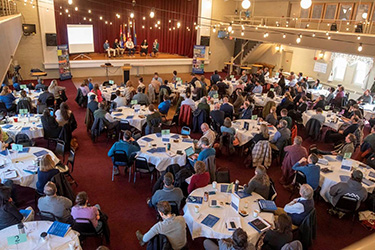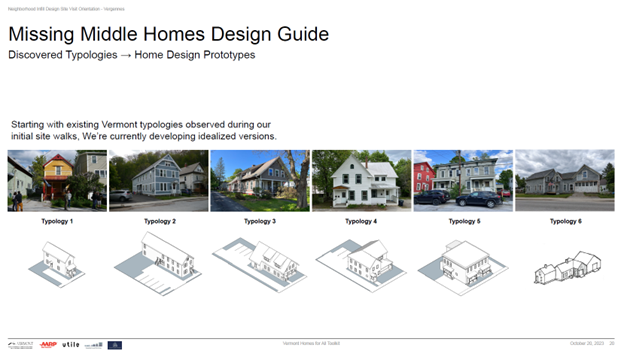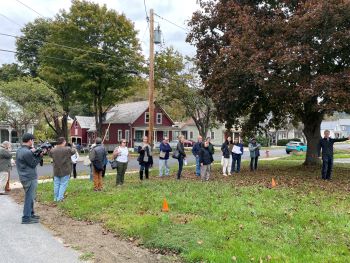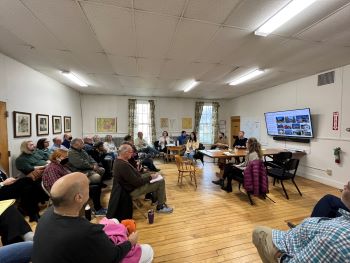
The Homes for All Toolkit is Here!
Homes for All Toolkit (PDF), Viewing recommendation is using 2-page view setting.
Slides from Homes for All Event
Sample Pro Formas
- Parallel Pro Forma (xls)
- For Rent Pro Forma (xls)
- For Sale Pro Forma (xls)
(The pro forma inputs associated with this workbook make no claims to being accurate in any market, only educational to see how the pieces work individually and together. All assumptions should be verified individually by the small-scale developer themselves).
Homes For All Webinar (video)
Homes for All Toolkit Trainer Summit
 On March 14, 2024 the Department of Housing & Community Development launched the VT Homes for All Toolkit to a maximum capacity crowd at the Toolkit Trainer Summit in Barre.
On March 14, 2024 the Department of Housing & Community Development launched the VT Homes for All Toolkit to a maximum capacity crowd at the Toolkit Trainer Summit in Barre.
The half-day event brought together novice and emerging small-scale home builders, community development professionals, and local leaders interested in innovative home-building and home-renovation solutions to connect, network, and learn.
Couldn't make it? Watch the Summit recording here!
Project Introduction

Vermonters need better housing options and more affordable homes. Meeting that need requires changing the ways homes are built in Vermont, especially the location and types of new homes.
Today, Vermont’s home production is principally producing large, expensive single-family homes on large and mid-size lots, and large-scale multi-family apartments. Vermonters looking for housing options in-between, like a duplex or four-plex, cooperative housing, senior housing units, age-friendly homes, or townhouse condominiums have very limited options. Regulatory and financial barriers have made developing diverse homes on a small footprint harder and more complicated for people who want to earn a living this way and contribute to communities they love. This project aims to change that. Now is the time to unravel the regulatory complexity and revive common sense solutions that work for Vermont.
For more information, see the Homes for All Annual Report.
What are Missing Middle Homes?
Missing Middle Homes are rooted in Vermont’s pre-1945 development pattern and are increasingly viewed by Vermont housing leaders as a way to deliver diverse and affordable housing choices in convenient, existing walkable neighborhoods and places.
Missing Middle Homes (MMH) include home types like accessory dwelling units (ADUs), duplexes, small-scale multi-household buildings, and neighborhood-scale mixed-use/live-work buildings – common before local zoning codes began to separate different kinds of uses and building types. Traditionally, American neighborhoods provided a diverse mix of housing options for homeowners and renters that worked for people of different ages, abilities, and walks of life. Over the 20th century, we made many of those options illegal or limited where they could be built which, more than anything else, undermined the walkability and vitality of our would-be 15-minute neighborhoods. How do we reverse this? We must allow every neighborhood to incrementally fill in with housing options that meet people’s real needs.
What Will the Project Do?
The Vermont Homes for All Toolkit and community engagement process will re-introduce MMH to Vermont by focusing statewide attention on small-scale gentle infill and incremental development as a strategy to address Vermont’s housing and affordability crisis. This approach is emphasized by Enabling Better Places: A Zoning Guide for Vermont Neighborhoods.
This ‘Design & Do’ Toolkit will produce four deliverables useful to housing champions across Vermont, including prospective and emerging small-scale developers, planning and regulatory policymakers, municipal and community leaders, and Vermont-based technical advisors for MMH:
- Missing Middle Homes Design Guide - A design guide for Missing Middle Homes in a broadly appealing Vermont architectural vernacular.

- Vermont Neighborhood Infill Design Case Studies - A series of five case studies showing how MMH building designs can be integrated into existing Vermont neighborhoods and communities using illustrated visualizations. These case studies and visualizations will be generated in partnership with five pilot communities.

- Builders’ Workbook - A Missing Middle Home builders’ how-to workbook that provides a comprehensive roadmap to real estate development for first-timers. This workbook will provide guidance on a variety of considerations including regulations and zoning, financing, infrastructure, and design, as well as advice on potential partners that can help beginner developers achieve success.
- Training Resources - A complete package of training resources for regional and local planning and economic/community development leaders to promote the toolkit and transfer knowledge. The full toolkit, including these Training Resources, will be used for the first time as part of a MMH leadership summit in the spring of 2024.
This project has a robust focus on community engagement, including underrepresented and nontraditional players and communities in the housing space, which is critical to this project’s mission of increasing diverse, affordable housing options for all Vermonters.
Goals
Through this project, we strive to:
- Build Affordably - Demonstrate how MMH-types that are characteristically Vermont and well loved by locals can be both of a high quality and affordable by design (including affordability through building approaches, construction materials, energy efficiency, site design, and flood resilience).
- Grow Small Developers - Attract a new generation of grassroots investors/developers (including first-time, women and Black and Indigenous people of color (BIPOC) builders and developers committed to their community and ready to build walkable neighborhoods and missing middle homes and earn a living doing so) by showing small-scale developers and individual property owners what’s possible and how they can do it with start-to-finish ‘how-to’ resources.
- Cultivate Local Support - Assist community leaders and policy makers by helping them visualize missing middle infill and ways they can make it easier to build missing middle housing through predictable and streamlined development processes, and permit-ready designs that does not result in displacement, overcrowding, or loss of existing affordability.
- Empower MMH Champions - Generate interest and enthusiasm for MMH, engage, and empower new small-scale home builders and help community leaders visualize how missing middle designs can help build vibrant and inclusive places through neighborhood infill opportunities (from accessory dwellings to mixed-use buildings in Vermont’s civic and commercial centers).
Project Timeline
DHCD has selected Utile Architecture & Planning of Boston as consultant for the MMH project with the support of Neil Heller of Neighborhood Workshop and Liz Curry of CommonLand Solutions. The Utile Team’s design, planning, community engagement, and technical assistance in creating thoughtful, context-oriented infill development, forging strong community partnerships, and communicating planning and design ideas to a wider audience will be an asset in ensuring this project’s success.
- A project kickoff event was held on May 25, 2023. Click here to view the kickoff presentation.
- June 2023: DHCD put out a call for communities to apply for the Neighborhood Infill Design Case Studies. Through a competitive review process, Bellows Falls, Arlington, Rutland City, Vergennes, and Middlesex were selected as case study communities.
- October 18-20, 2023: The state and consultant team visited the five case study communities. Each community received a half-day site visit from the design team, including a public presentation about missing middle and infill housing and a walking tour. Public participation was robust, and media coverage includes
- State project imagines new housing in 5 Vermont communities” - VTDigger
- “Vt. Officials tour communities for missing-middle home ‘toolkit’” – WCAX
- “Bellows Falls part of state pilot project on ‘missing middle housing’” – Brattleboro Reformer
- “Arlington takes a close look at ‘missing middle homes’ at Town Hall meeting” – Bennington Banner
- “Middle Ground” – The Bellows Falls Commons
- “‘Homes for All’ in Arlington” – Greater Northshire Access Television
- “State consultants talk housing” – Rutland Herald


- March 2024: The Homes for All toolkit will launch at the Toolkit Trainer Summit. Stay tuned for the exact date and location!
Community Engagement & Partnerships
Steering Committee
The Steering Committee will advise on key issues, contextual factors, and technical issues; assist with coordination and alignment with existing policies as well as ongoing or future projects and initiatives; assist with outreach, communication and increasing awareness of the project to boost participation and understanding with key stakeholders, agencies, and members of the public; and review and provide feedback on proposed process, initial findings, interim deliverables and final Toolkit.
- Leslie Black Plumeau, Research and Community Relations Manager, Vermont Housing Finance Agency
- Emily Phillips, Associate Housing Director, Vermont Housing and Conservation Board
- Kelly Stoddard-Poor, Associate State Director, AARP Vermont
- Kelly Lucci, Director of Strategy and Partnerships, Vermont Energy Investment Corporation
- Bill Colvin, Executive Director, Bennington County Regional Commission
- Kati Gallagher, Sustainable Communities Program Director, Vermont Natural Resource Council
- Katie Buckley, Director, Federal Funding Assistance Program, Vermont League of Cities and Towns
- Chris Halnon, Business Loan Officer, New England Federal Credit Union
- Jonah Richard, Principal, Village Ventures
- Zak Hale, Hale Resources
Technical Advisory Group
The Technical Advisory Group will provide on-call advising based on their area of technical expertise as well as reviewing and providing feedback on interim deliverables and final Toolkit.
The Technical Advisory Group consists of a range of relevant stakeholders, including small-scale developers, policy makers, realtors, lenders, legal experts, architects, engineers, DEI advisors, and more.
Neighborhood Infill Design Case Studies
In June 2023, DHCD put out a call to communities passionate about creating new housing opportunities to apply to be a Homes for All case study community. The case studies will help communities visualize missing middle infill and ways you can make it easier to build missing middle housing through predictable and streamlined development processes, and permit-ready designs that do not result in displacement, overcrowding, or loss of existing affordability. Through a competitive review process, the five selected communities are: Bellows Falls, Arlington, Rutland City, Vergennes, and Middlesex.
Each community received a half-day visit with our project consultants in late October 2023. Communities will receive visualizations that will serve as problem-solving tools for the community, illustrating strategies for advancing context-sensitive designs that meet City and Town regulations and community design objectives, and that are feasible from a market perspective. Stakeholders can use the test-fit visualization to consider alternative configurations and explore ways in which they can overcome some common and unique challenges of infill development in small sites or settings.
Related Vermont Initiatives:
• Enabling Better Places: A Zoning Guide for Vermont Neighborhoods (2020): A guide for local leaders to enable better places and create great neighborhoods through zoning for a variety of housing types.
• Planning Act Reforms (2020, 2021, 2022, 2023): Updates like limiting minimum parking required for an accessory dwelling unit to one space per bedroom.
• Bylaw Modernization Grants (2022 - 2024): Funding for municipal bylaw updates to expand missing middle house choice and opportunity in zoning. Round 1 was awarded in January 2021, with project completion by January 2024; round 2 funding awards was awarded in January 2023, with project completion by 2025.
• Vermont Housing Improvement Program (2022 & 2023): Grants to rental property owners up to $50,000 per unit to bring vacant and blighted rental units back online and support accessory dwelling unit production.
• Missing Middle Income Home Ownership Development Program (VHFA) (2023): Subsidies to support developers of modest homes sold at affordable prices to middle-income Vermonters.
• Community Partnership for Neighborhood Development (S.226/Act 182, section 4) (2023) An upcoming collaboration among cross-agency and cross-government stakeholders to pilot a new model of strategic partnership and coordinated public investment to develop and re-develop new neighborhood infrastructure and build needed homes.
Key Terms Definitions:
- Gentle Infill - Infill compatible with existing surroundings to achieve urban design goals. Many times, this type of new development goes largely unseen due to its location within or behind an existing structure.
- Incremental Development - Small-scale development that is primarily undertaken by developers who live in the community they are operating in. This term includes both housing and commercial development types. Can also be a development strategy.
- Accessory Dwelling Units (ADU) - a technical term used most by planners, inspectors, and governments referring to a home that is secondary to the primary home on a single platted property containing all the facilities necessary for living, including cooking and sleeping.
- Missing Middle Homes - a housing term that describes a range of house-scale residential building types that have multiple units that are compatible in scale and form with detached single-family homes. Examples include duplexes, townhouses, or courtyard apartments. This is also sometimes referred to as “Missing Middle Housing” and when used outside the context of this project, often does not include ADUs or neighborhood-scale commercial and mixed-use building types and focuses solely on multi-unit homes. However, for the purposes of this project we are using a more expanded definition to capture the range of “in-between” home types that are a good fit for the Vermont context.
